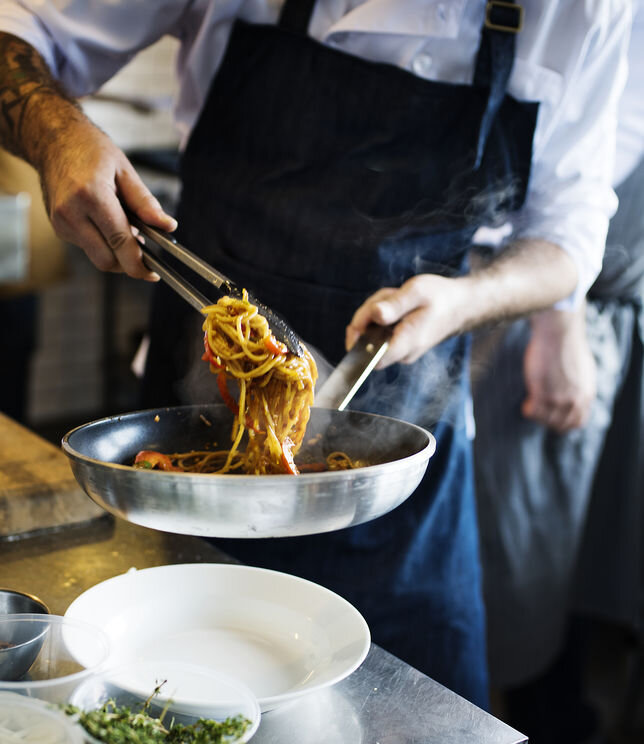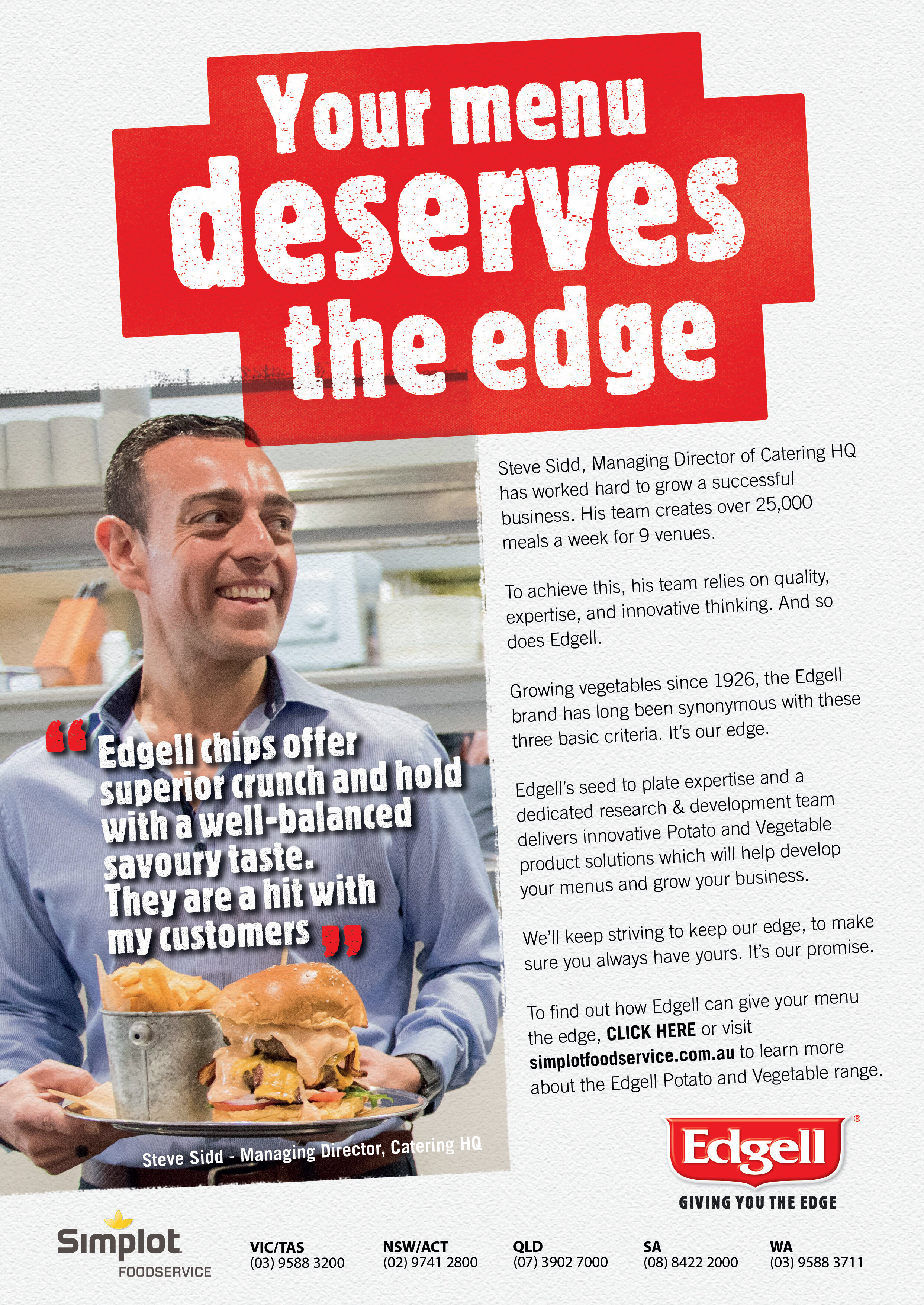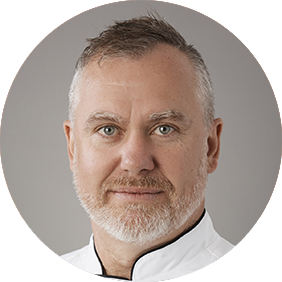Effective menu planning and costing is imperative if you want to stay in business
Effective menu planning and costing is essential for any foodservice business seeking to stay in the game. To find out more about the right way to go about it, as well as the pitfalls to avoid, we spoke to two seasoned foodservice professionals with experience of both largescale event catering and smaller restaurant and café fare – Peter Wright and Markus Werner.
PETER WRIGHT
FSR Consultant Chef
“One of the most important points to remember is that once you’ve bought it, you’re paying for it – in other words once you place the order it’s costing you money, so avoid buying things on a whim or because someone’s doing an upselling job on you.”
Peter Wright recommends that you think of your ingredients as assets – and ask how many times you can use them in your menu. “Even if you open up a 2 kilo can of tomato paste, ask yourself how long it’s going to take you to use it, how many dishes can you use it in, are you going to waste any of it? Any ingredient has to be thought through right to the last drop. Every bit of food that goes in the bin, every vegetable scrap, every meat offcut all costs you, and when you consider the average cost of vegies is $10 a kilo, then if you’re throwing away 5 kilos a week that’s costing you $50. So you do need to think about how you maximise your assets.”
A corollary to this is to look at the ingredients in your pantry and ask how you can reduce them without impacting the menu. “If you’re in a fine dining, three hatted restaurant you can afford to be a bit more extravagant because every dish is tailored to a flavour or an outcome, but in an average style place you need to ask yourself: do I need 12 different breads on the menu, five different chicken dishes, five steaks – can I do four or even less? So reduce your pantry list as much as possible, then put some specials on and maximise those – that’s always a good way to get better value out of your menu and lower your cost of goods.”
Peter also advises considering the combined costs of your food and labour – “There are a lot of products today which can be bought ready-prepared, like trimmed and peeled vegies, par-baked breads, vegetable purees, which won’t impact the outcome on the plate but take away a lot of prep work. So instead of making a carrot puree which might take an hour, buy it already prepared but add your own flavour to it. That way you’re still adding your own signature to the dish, but because you’ve bought the product there's a labour value attached to it. So your cost of goods might go up, but your labour cost will go down and the combination of the two is still sitting at 60 per cent of the price of the dish.
Another important point is to be able to cost both food and labour out in advance – “You need to cost out your purchases before you buy them, cost out your labour before you post your roster – put that against your revenue forecast so you can then say ‘I’m a bit too high, I need to cut this or that back’. Another point, and this is something that does take a little experience, is to try and anticipate what people are going to order.
“This is particularly important on big events where even small mistakes can cost hundreds of thousands of dollars.”
“If you’ve got 10 main courses on your menu, I run what I call a demand table next to the ingredients list.”
“There's 100 people coming for dinner, the fillet steak is going to be 30 per cent of the uptake, the chicken main course will be 20 per cent, the vegetarian main course will be 10 per cent and so on. Then you purchase against the expected uptake - but you can't just make it up, it’s got to be based on historical data and sometimes you get it wrong.”
“You shouldn’t need to worry about falling short - you've always got tomorrow’s ingredients in the kitchen anyway so you can draw from those, but at least this way you’re thinking about what people are likely to order before they order it, and then analysing the actual information on a daily basis. As the head chef you should be working out how much of everything is selling and what’s trending anyway.”
Working out your meal costs needn’t be time-consuming
A related principle is what’s known as ‘just in time’ ordering, and as Peter points out, “COVID has changed the way people stockpile food, but it’s OK to say you've sold out. You might put a barramundi special on the menu but then 15 tables order it and it sells out. That shouldn’t be frowned upon – of course if you run out of five dishes it's a different story!”
He adds that working out your meal costs needn’t be a time-consuming task. “Take for example a chicken main course – if you take a basket of vegies, say potatoes, broccoli, pumpkin and some herbs, and work out the average cost of that is $10 per kilo straight off the bat, and the average portion size of vegies per plate in your restaurant is 100g, then the average cost of vegies on all your plates is $1. If your chicken costs $10 per kilo, the average price for chicken in your restaurant is $2. If your sauce costs $20 per litre and you’re doing 50ml serves that’s another $1. So that’s $4 average cost per plate for the chicken dish on your menu.
“And if you apply that across every dish you can work out an average price for each dish. If you do that for each dish it’ll be about 90 per cent accurate. So you can work out the average cost of your entire menu within a couple of hours, and if you then
apply that to each day’s uptake you can work out your food costs in about 20 minutes. You don’t need to use complex software, it can be a simple spreadsheet. If you go to a successful restaurant and ask how’s your labour costs going, I guarantee they can tell you what it is for each day. You really need to understand these metrics to stay in business and it’s just not that complicated to work it out.”
Sticking with local suppliers can work to your advantage
In his capacity as Corporate Executive Chef of Delaware North Australia, Markus Werner is a keen advocate of the “paddock to plate” philosophy which he says works in his favour when it comes to menu planning: “If you’re sourcing product from large suppliers, large abattoirs and so on, you will occasionally get good deals but you also tend to have quite large fluctuations in pricing – whereas when you stick to smaller local suppliers, they tend to appreciate your business so they’re not changing pricing so often. If you’re going with a larger supplier then maybe if you’re buying in bulk you can make a quick saving, but with regular smaller suppliers I think you have more consistency, and you save in the long run – besides which the quality is so much better. Even with a big company like Delaware North, you might think they would only buy from the bulk suppliers but in fact they are keen to support the smaller producers. So I think it pays to stick with local suppliers and it will work to your advantage.”
Markus makes the point that sourcing fresh produce locally also means you need to have a seasonal focus. “Certain items you’ll want a year round supply of, but generally you’ll be following the seasons. The other point is that while food used to be the bulk of your cost, these days it’s labour so you have to engineer your menus more cleverly so you’re not spending too much time plating up – labour can make or break your business these days. So you need to think about each component of your menu in terms of how long it will take to produce it and plate it. That’s where you have to be smart, especially when you’re dealing with large events. Again, it’s so important to have strong relationships with your suppliers because you’re trusting them to go and find you the best products available.”
MARKUS WERNER
FSR CONSULTANT CHEF
“There is a lot of software you can use to assist with costings today, but in any case you need to know 80 per cent of your costings off the top of your head to be able to move quickly and shift with the market.”
“This gives you the ability to steer away from certain products because they’re too costly or the quality is not there.”
“I’ve never really been a fan of cheap ingredients, because I think it always comes back on you in a negative way – cheap means it’s sourced cheaply or something’s wrong with it. I think it’s always better to look for quality - you don’t want to have to be constantly shopping around because then your quality won’t be consistent.”
Markus adds that it’s OK to charge more for a dish as long as the quality is there to back up the price point. “We’re using fresh cooked 100 per cent beef patties from Gippsland for the burgers in our stadiums and the quality writes its own story. People are happy to pay $10 for a burger when the quality is fantastic and they can taste that’s its freshly ground, freshly grilled beef from a local supplier – what better can you get? It’s a minimal extra cost for a better product and customers are happy to pay it. I think you get more complaints from customers when the quality isn’t there – if you give them better quality then they think ‘this is value for money, I can’t get this food for this price at home’.”
“You need to look at the menu as a whole, not just as a series of dishes. Realistically a lamb cutlet costs $4 so can you sell it for $20? – no, you’d be kidding yourself.”
“This is why it’s so important to know the price of your whole menu – you might occasionally take a hit on certain products, because this one’s not a revenue maker, but this one helps your labour costs; this one’s not as expensive so it helps your food costs.”
“The steak will have maybe a 40 per cent food cost but the labour cost is very small because it’s just a steak served with salad, so you’re getting good revenue from it. In other words the engineering of the whole menu is very important and you have to factor all this in.”







